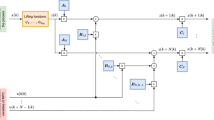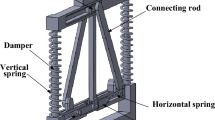Abstract
The focus of this paper is on the formalisation of the influence of a jerk-controlled movement law on the vibrations of industrial high-speed systems, i.e. systems for which axes are submitted to significant dynamical demands. Analysis of the physical relationship between the jerk limit and the maximum vibratory amplitude is conducted on a simplified axis drive model that simultaneously accounts for axis control parameters and predominant mode effects. Experimental measurements conducted on three tests-setups demonstrate the effectiveness of the proposed approach in accurately predicting the evolution of the vibration level according to the constant jerk stages time and the axis drive parameters.
Similar content being viewed by others
References
Bearee, R., Barre, P.-J., and Bloch, S.: 2004, Influence of high-speed machine tool control parameters on the contouring accuracy. Application to linear and circular interpolation, J. Intelligent Robotic Systems 40, 321–342.
Benning, R. D., Hodgins, M. G., and Zipfel, G. G.: 1997, Active control of mechanical vibrations, Bell Labs Technical J. (1997), 246–257.
Bopearatchy, D. L. P. and Hatanwala, G. C.: 1990, State space control of a multi link robot manipulator by a translational modelling technique, in: Proc. of the 5th IEEE Internat. Symposium on Intelligent Control, Philadelphia, USA, pp. 285–290.
Chang, B. H. and Hori, Y.: 2003, Trajectory design considering derivative of jerk for head-positioning of disk drive system with mechanical vibration, in: Proc. of the American Control Conf., Denver, CO.
Ellis, G.: 2000, Control System Design Guide, 2nd edn, Academic Press, Boston.
Flies, M., Levine, J., Martin, Ph., and Rouchon, P.: 1995, Flatness and defect of non-linear systems: Introductory theory and examples, Internat. J. Control 61(6), 1327–1361.
Groß, H., Harmann, J., and Wiegârtner, G.: 2001, Electrical Feed Drives in Automation, MCD Corporate Publishing, Siemens.
Harris, C. M.: 2004, Exploring smoothness and discontinuities in human motor behaviour with Fourier analysis, Math. Biosci. 188, 99–116.
Hindle, T. A. and Singh, T.: 2000, Desensitized minimum power/jerk control profiles for rest-to-rest maneuvers, in: Proc. of the American Control Conf., Chigago, IL, June.
Lee, T. S. and Lin, Y. J.: 1998, An improved sculptured part surface design with jerk continuity for a smooth machining, in: Proc. of the IEEE Internat. Conf. on Robotics & Automation, Leuven, Belgium, May.
Macfarlane, E. and Croft, E. A.: 2001, Design of jerk bounded trajectories for on-line industrial robot applications, in: Proc. of IEEE Robotics Automation Conf., Seoul, S. Korea, pp. 979–984.
Papiernik, W.: 1996, Architecture and design of modern CNC/drive systems, Intelligent Motion (May), 271–280.
Piazzi, A., and Visioli, A.: 2000, Global minimum-jerk trajectory planning of robot manipulators, Proc. IEEE Trans. Industr. Electronics 47(1).
Picard, D. B.: 2004, Influence of movement laws on high-speed machines vibrations (in French), in: Proc. of the 3rd Machine-Tool and High-Speed Machining Conf., Clermont-Ferrand, France.
Spinnler, G.: 1997, Machines Designs – Principles and Applications, Vol. 3 (in French), Presses Polytechniques et Universitaires Romandes, Lausanne, Switzerland.
Yamamoto, T., Tanaka, K., and Sumiyoshi, M.: 1996, Vibration control for Cartesian 3 axes robot, in: Proc. of Workshop on Advanced Motion Control, Tsu-city, Japan.
Author information
Authors and Affiliations
Corresponding author
Rights and permissions
About this article
Cite this article
Barre, PJ., Bearee, R., Borne, P. et al. Influence of a Jerk Controlled Movement Law on the Vibratory Behaviour of High-Dynamics Systems. J Intell Robot Syst 42, 275–293 (2005). https://doi.org/10.1007/s10846-004-4002-7
Issue Date:
DOI: https://doi.org/10.1007/s10846-004-4002-7




